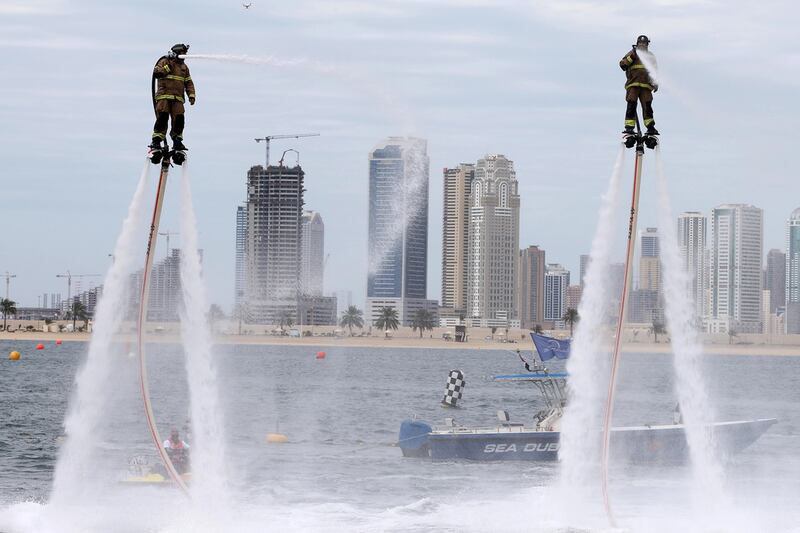DUBAI // Drones are being tested to lift firefighting equipment on to burning high-rises and locate people trapped inside.
The remote-controlled devices would use thermal-imaging cameras to find people and fire flashpoints, and could be used to carry gear to battle blazes from next year, civil defence officials revealed on Wednesday.
Tests are being carried out on 15 drones in a special civil defence unit and more devices will be commissioned as part of efforts to swiftly save lives and contain damage to property.
“We are mainly thinking how we can use the drones to lift equipment up to high-rise floors,” said Col Ali Al Mutawa, assistant general director for smart services with Dubai Civil Defence.
“We are testing the lifting at the moment. The drones have a certain capacity in terms of load. Hopefully, by the beginning of next year we will use it.”
Col Al Mutawa was speaking at the Fire Safety Technology Forum UAE in Dubai.
Drones are also being used to help find the fire and, through live video streaming, help the fire commander to size up the situation, he said.
Similar devices are already being used in the US to investigate forest fires, evaluate the severity of a blaze in buildings and to assist firefighters.
The drone testing in Dubai is part of a wider move to use technology in emergency situations.
“We are always seeking to mitigate the loss to life and property and our ultimate goal is to do this with innovation,” said Maj Gen Rashid Al Matrooshi.
“The main goal is to prevent loss of lives and we are using smart systems to reduce any risk in buildings.
“Every time we go higher, the risks are high and the procedures for prevention are higher.
Col Al Mutawa said nanotechnology was being used in fire extinguishers and protective fire suits to prevent fires caused by electrical overloads.
Officials last year spoke of intelligent systems in buildings, which would release a fire extinguishing gas when temperatures hit a danger mark.
And this year, officials unveiled the Dolphin system to tackle marine blazes using a jetpack and jet skis.
Peter Stephenson, associate director of fire engineering at Burohappold Engineering, said video smoke detectors were effective tools.
“If you have a forest fire a technique using video smoke detection and heat mapping can be used so you can cover a large area and a similar thing could be done with drones,” Mr Stephenson said.
“It’s very important to look at how drones integrate into an operational response.”
It was also crucial for planners to work with civil defence from the design stage to block off safe areas for firefighters to operate.
“When a building is evacuated there should be assembly points and a rendezvous point for civil defence. The building management should have a pre-arranged place to meet civil defence,” Mr Stephenson said.
“This should be built into the design and that’s why it is important to have the involvement of civil defence throughout the whole design process.”
James Singeltary, managing director of R2 Squared, a decontamination and thermal insulation company, highlighted the need to protect firefighters, first responders and forensic teams from toxic gases that remain on gear and clothing after they leave a fire scene.
“Firefighters are protected with their clothing but it’s a toxic soup of gases inside,” Mr Singeltary said. “We don’t know the short-term or long-term effect when they come out and remove their gear because then they are touching it.”
Forensic teams who keep equipment in personal vehicles could expose their families to the poisonous gases, causing severe headaches and nausea.
Dubai Civil Defence officials said protective clothing, random blood tests and check-ups kept firefighters safe.
“We have gas detection to detect the type of gas and also to detect how much the firefighter has inhaled,” Col Al Mutawa said.
“We are monitoring every single firefighter in Dubai.”
rtalwar@thenational.ae






